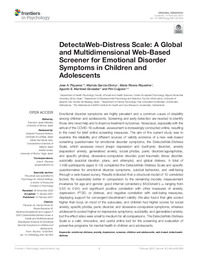Por favor, use este identificador para citar o enlazar este ítem:
https://hdl.handle.net/11000/36083Registro completo de metadatos
| Campo DC | Valor | Lengua/Idioma |
|---|---|---|
| dc.contributor.author | Piqueras, Jose A | - |
| dc.contributor.author | Garcia-Olcina, Mariola | - |
| dc.contributor.author | Rivera-Riquelme, María | - |
| dc.contributor.author | MARTINEZ-GONZALEZ, AGUSTIN ERNESTO | - |
| dc.contributor.author | Cuijpers, Pim | - |
| dc.contributor.other | Departamentos de la UMH::Psicología de la Salud | es_ES |
| dc.date.accessioned | 2025-03-24T08:22:46Z | - |
| dc.date.available | 2025-03-24T08:22:46Z | - |
| dc.date.created | 2021-02-15 | - |
| dc.identifier.citation | Frontiers in Psychology, 15 February 2021, Sec. Psychology for Clinical Settings, Volume 12 | es_ES |
| dc.identifier.issn | 1664-1078 | - |
| dc.identifier.uri | https://hdl.handle.net/11000/36083 | - |
| dc.description.abstract | Emotional disorder symptoms are highly prevalent and a common cause of disability among children and adolescents. Screening and early detection are needed to identify those who need help and to improve treatment outcomes. Nowadays, especially with the arrival of the COVID-19 outbreak, assessment is increasingly conducted online, resulting in the need for brief online screening measures. The aim of the current study was to examine the reliability and different sources of validity evidence of a new web-based screening questionnaire for emotional disorder symptoms, the DetectaWeb-Distress Scale, which assesses mood (major depression and dysthymic disorder), anxiety (separation anxiety, generalized anxiety, social phobia, panic disorder/agoraphobia, and specific phobia), obsessive–compulsive disorder, post-traumatic stress disorder, suicidality (suicidal ideation, plans, and attempts), and global distress. A total of 1,499 participants (aged 8–18) completed the DetectaWeb-Distress Scale and specific questionnaires for emotional disorder symptoms, suicidal behaviors, and well-being through a web-based survey. Results indicated that a structural model of 10 correlated factors fits reasonably better in comparison to the remaining models; measurement invariance for age and gender; good internal consistency (McDonald's ω ranging from 0.65 to 0.94); and significant positive correlation with other measures of anxiety, depression, PTSD, or distress, and negative correlation with well-being measures, displaying support for convergent-discriminant validity. We also found that girls scored higher than boys on most of the subscales, and children had higher scores for social anxiety, specific phobia, panic disorder, and obsessive–compulsive symptoms, whereas adolescents scored higher on depressive symptoms, suicidality, and generalized anxiety, but the effect sizes were small to medium for all comparisons. The DetectaWeb-Distress Scale is a valid, innovative, and useful online tool for the screening and evaluation of preventive programs for mental health in children and adolescents. | es_ES |
| dc.format | application/pdf | es_ES |
| dc.format.extent | 14 | es_ES |
| dc.language.iso | eng | es_ES |
| dc.publisher | Frontiers Media | es_ES |
| dc.rights | info:eu-repo/semantics/openAccess | es_ES |
| dc.rights.uri | http://creativecommons.org/licenses/by-nc-nd/4.0/ | * |
| dc.subject | emotional | es_ES |
| dc.subject | distress | es_ES |
| dc.subject | anxiety | es_ES |
| dc.subject | depression | es_ES |
| dc.subject | screener | es_ES |
| dc.subject | children and adolescents | es_ES |
| dc.subject | web-based | es_ES |
| dc.subject | detectawebdistres | es_ES |
| dc.subject.other | CDU::1 - Filosofía y psicología::159.9 - Psicología | es_ES |
| dc.title | DetectaWeb-Distress Scale: A Global and Multidimensional Web-Based Screener for Emotional Disorder Symptoms in Children and Adolescents | es_ES |
| dc.type | info:eu-repo/semantics/article | es_ES |
| dc.relation.publisherversion | https://doi.org/10.3389/fpsyg.2021.627604 | es_ES |

Ver/Abrir:
2021_136_Investigacion_Publicaciones_Detectaweb Distress.pdf
351,26 kB
Adobe PDF
Compartir:
 La licencia se describe como: Atribución-NonComercial-NoDerivada 4.0 Internacional.
La licencia se describe como: Atribución-NonComercial-NoDerivada 4.0 Internacional.
.png)